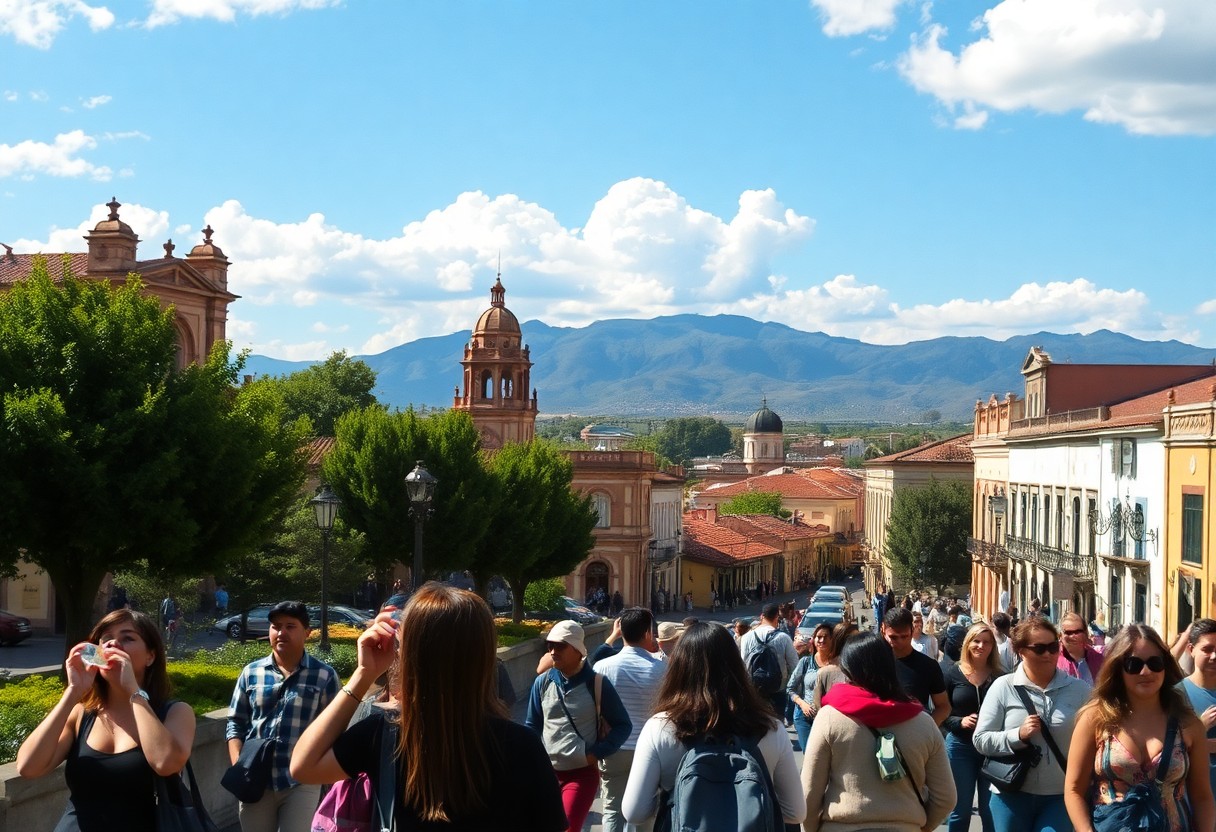San Miguel de Allende is celebrated for its breathtaking aesthetics and unique allure, yet one of its most surprising features is its elevation. Nestled at a stunning 6,200 feet above sea level, this captivating city brings with it specific altitude challenges that can greatly impact your travel experience. As you acclimate to the thinner air, you may notice symptoms like mild headaches, shortness of breath, or general fatigue. Though these effects are typically short-lived, they can be uncomfortable for some travelers. By gaining insight into how altitude affects your body and preparing appropriately, you can ensure a more enjoyable and comfortable journey to this stunning Mexican destination. Staying properly hydrated, pacing your activities, and being attentive to your body's signals will enable you to fully embrace the high-altitude charm of San Miguel de Allende.

Comprehending the Unique Altitude and Climate of San Miguel de Allende
The elevation of San Miguel de Allende plays a pivotal role in defining its unique atmospheric conditions, which can significantly affect your travel experience. The city is situated within the Mexican highlands, where the high altitude presents distinct altitude challenges that may impact both your comfort and health during your stay. Understanding these environmental aspects will empower you to prepare effectively and adjust to the local climate, ultimately enhancing your overall enjoyment of this extraordinary destination.
Essential Altitude Information for Informed Travelers
San Miguel de Allende boasts an altitude of approximately 6,132 feet (1,870 meters), making it a prominent high-altitude destination. This elevation can trigger physiological reactions in visitors, including mild symptoms of altitude sickness or alterations in breathing patterns. You might experience slight breathlessness during your initial days, especially during physical exertion. Being aware of this aspect of your trip will aid in planning effectively and alleviating any discomfort you may encounter.
Understanding the Climate Traits of San Miguel de Allende
The climate in San Miguel de Allende is characterized by pleasant temperatures and relatively dry conditions, making it an attractive destination throughout the year. Expect warm days accompanied by cool nights, leading to notable temperature fluctuations across the seasons. The high-altitude environment contributes to a comfortable climate that draws numerous international visitors seeking an enjoyable escape.
This city experiences a semi-arid subtropical highland climate, which features distinct dry and wet seasons. The dry season spans from November to April, showcasing bright sunny days with minimal rainfall. In contrast, the rainy season, occurring from May to October, introduces invigorating afternoon thunderstorms that refresh the landscape. When planning outdoor excursions, it’s essential to consider these seasonal variations and dress in lightweight layers to adapt easily to changing temperatures throughout the day.
Identifying Common Altitude-Related Symptoms for Better Travel Preparation
If you plan to visit San Miguel de Allende, located at an elevation of approximately 6,200 feet, it’s vital to be aware of potential altitude-related symptoms you might experience. At this significant elevation, your body may undergo physiological changes that could impact your comfort and health, leading to mild to moderate discomfort during your initial days in this beautiful Mexican locale.
Recognizing Common Symptoms Experienced by Travelers
During your stay in San Miguel de Allende, you may encounter a variety of altitude-related symptoms, ranging from mild to more pronounced experiences. Visitors frequently report symptoms such as headaches, fatigue, shortness of breath, and occasional dizziness. Additionally, some travelers experience decreased appetite, mild nausea, and interrupted sleep patterns as their bodies adjust to the increased elevation. Being informed about these symptoms will aid you in preparing for your trip and responding effectively to your body’s needs.
Key Factors Affecting Altitude Symptoms in Visitors
Multiple critical factors can shape your altitude experience during your time in San Miguel de Allende:
- Personal fitness level
- Hydration status
- Previous altitude exposure
- Age and overall health
Understanding these influencing factors will equip you with the knowledge necessary to prepare adequately for your visit, ensuring a smoother transition to the high-altitude environment.
Comprehensive Analysis of Influencing Factors for Altitude Adaptation
Various elements contribute to how you may experience altitude in San Miguel. Important factors include:
- Physical conditioning
- Acclimatization speed
- Cardiovascular health
- Genetic predisposition
Recognizing these nuanced influences can significantly affect your adaptation strategy, enhancing your overall comfort during your visit.

Proven Prevention Strategies and Health Tips for Travelers Visiting San Miguel de Allende
Traveling to San Miguel de Allende at an elevation of 6,200 feet requires careful preparation to effectively manage potential altitude effects. It’s essential to approach your trip with proactive health strategies that can mitigate risks and enhance your overall experience. By understanding and implementing targeted prevention methods, you can significantly reduce the chances of encountering altitude-related symptoms and fully enjoy your journey in this captivating Mexican city.
The Vital Importance of Hydration for High-Altitude Travelers
Preventing altitude sickness fundamentally starts with maintaining excellent hydration. Aim to drink more water than usual, targeting at least 3-4 liters daily. Your body requires increased fluid intake to compensate for elevated respiratory rates and potential fluid loss that occurs at higher elevations in San Miguel de Allende. Staying hydrated is crucial for ensuring that your body adjusts effectively to the altitude.
Acclimatization Techniques to Enhance Comfort
Health experts recommend gradual altitude adaptation strategies for visitors to San Miguel. It's wise to structure your first few days with minimal physical exertion, allowing your body to adjust naturally to the altitude. Engaging in gentle movements, taking frequent rest periods, and avoiding strenuous activities will assist your physiological systems in acclimatizing effectively.
Successful acclimatization necessitates a strategic approach to your daily activities. Spend your initial days at a relaxed pace, incorporating short walks, and paying attention to your body's signals. Monitoring your energy levels and avoiding rapid ascents can significantly lessen altitude-related stress.
Nutritional Guidelines for High Altitude Travelers
Alongside hydration, your dietary choices play a vital role in altitude adaptation. It’s beneficial to consume high-carbohydrate, low-salt meals that support metabolic processes and help sustain energy levels. Light, nourishing foods will facilitate your body’s adjustment to the elevated environment of San Miguel.
The importance of nutrition is paramount when visiting high-altitude destinations. Focus on easily digestible proteins, complex carbohydrates, and potassium-rich foods. Steering clear of heavy, greasy meals while maintaining a balanced diet will support your body’s adaptation to the unique challenges posed by the high elevation of San Miguel de Allende.
Sharing Insights and Personal Experiences from San Miguel de Allende
Throughout my exploration in San Miguel de Allende, I observed the profound effects of its high-altitude environment. At an elevation of 6,200 feet above sea level, the thin air presented challenges to my physical adaptation, creating a unique experience that reshaped my understanding of travel and personal resilience. The subtle effects of the elevation on my breathing and energy levels provided a captivating investigation into how our bodies respond to significant geographical changes.
Experiences Shared by Fellow Travelers
Travelers frequently share their unexpected physiological responses to the altitude in San Miguel through personal accounts. Many describe experiencing initial lightheadedness, reduced stamina, and a need to move slowly. Your first days may involve gentle acclimatization, with some visitors encountering mild symptoms such as headaches or slight fatigue, while others adapt more quickly to the elevated environment.
Practical Coping Strategies for Visitors Adjusting to Altitude
Visitors to San Miguel discover effective strategies for managing altitude-related challenges. It’s essential to prioritize hydration, consume lighter meals, and pace activities. Simple techniques such as deep breathing exercises and taking frequent rest breaks can significantly diminish potential discomfort while you explore this beautiful city.
Coping with altitude demands a comprehensive approach. Your body’s adaptation is influenced by various factors, including physical fitness, hydration levels, and individual physiological responses. Experts recommend a gradual increase in activity levels, avoiding alcohol initially, and choosing foods rich in complex carbohydrates. Consulting local healthcare professionals familiar with the specific altitude dynamics in San Miguel de Allende can help ensure a safe and enjoyable experience in this remarkable destination.

Expert Health Recommendations for an Enjoyable High Altitude Travel Experience
When planning your visit to San Miguel de Allende, it’s crucial to consider altitude-related health factors. Healthcare professionals strongly advocate for visitors to prioritize their well-being by understanding the potential physiological challenges that accompany being at an elevation of 6,400 feet. Your body requires time to acclimate; implementing proactive strategies can help minimize altitude-related discomfort.
Valuable Insights from Healthcare Experts
Medical professionals agree that gradual acclimatization is your best defense against altitude sickness in San Miguel de Allende. It’s essential to plan for rest during your first 24-48 hours, stay hydrated, and avoid strenuous activities. Your physician may recommend preventative medications or supplements to support your body’s adaptation to the higher elevation.
Accessing Specialized Health Resources for Visitors
San Miguel de Allende offers comprehensive support for altitude-related concerns, with local clinics and specialized travel health centers available. You can find medical professionals knowledgeable about the unique challenges of high-altitude environments who can provide tailored advice for your specific health needs.
Given the city’s popularity among international travelers, specialized medical resources are easily accessible. You will encounter English-speaking healthcare providers, diagnostic facilities, and emergency services equipped to address altitude-related medical issues. Many hotels and tourist centers can offer immediate referrals and assistance, ensuring prompt medical attention if needed.
Key Takeaways for a Memorable Visit to San Miguel de Allende
At elevations exceeding 7,000 feet, San Miguel de Allende presents unique altitude challenges that can significantly influence your travel experience. It’s essential to prepare by staying hydrated, moving at a leisurely pace, and allowing ample time for your body to acclimate. During your initial days, you might face mild symptoms like shortness of breath or slight headaches, which are common at this altitude. By drinking plenty of water, consuming light meals, and avoiding alcohol initially, you can minimize potential discomfort. Stay attuned to your body, take breaks as necessary, and savor the breathtaking beauty of this colonial city without overexerting yourself. By thoughtfully preparing, you can ensure a comfortable and unforgettable visit to this high-altitude Mexican gem.
Common Questions and Answers About Visiting San Miguel de Allende
What is the elevation of San Miguel de Allende, and why is it important for visitors?
San Miguel de Allende is situated at approximately 6,200 feet (1,890 meters) above sea level. This considerable high altitude can lead visitors to experience mild symptoms, including shortness of breath, headaches, and fatigue. The thinner air at this elevation results in reduced oxygen availability, impacting physical performance and comfort levels for travelers unaccustomed to mountainous environments.
What altitude-related health precautions should travelers observe when visiting San Miguel?
Travelers should prioritize hydration, consume light meals, and limit alcohol intake during their first 24-48 hours. Gradually engaging in physical activities will assist your body in adapting to the elevation. Walking slowly, resting frequently, and practicing deep breathing techniques can help minimize potential altitude-related discomfort. It is advisable for individuals with pre-existing respiratory or cardiovascular conditions to consult a healthcare professional prior to travel.
Are there specific times or seasons when altitude effects are more pronounced in San Miguel de Allende?
Altitude effects can be more pronounced during the dry season (November-April) when the air is thinner and humidity is lower. Visitors arriving during winter months might experience heightened symptoms. Daytime temperatures and sun exposure can also increase altitude sensitivity. Dressing in layers, staying hydrated, and allowing sufficient time for physiological adjustment can help alleviate potential challenges.
The Article: Altitude in San Miguel de Allende: How It Affects Visitors and What to Do About It appeared first on https://fallinginlovewithsanmiguel.com/
The Article Altitude in San Miguel de Allende: Impact on Visitors and Tips Was Found On https://limitsofstrategy.com



I really appreciate your insights on the altitude challenges in San Miguel de Allende. Having visited this beautiful city a couple of years ago, I can attest to the effects of the elevation. The first few days were certainly a mix of marveling at the stunning architecture and battling that slight headache. It’s fascinating how something as simple as altitude can impact our travel experience, reminding us just how adaptable (or not) our bodies can be.
It’s interesting to hear your experience in San Miguel de Allende, especially since so many travelers face that altitude adjustment challenge. The first few days in such a high-elevation city can be a real rollercoaster—one moment you’re lost in the city’s beautiful streets and vibrant culture, and the next, you’re trying to figure out how to tackle that headache. It really does put into perspective how our bodies cope with changes in environment.
I’m glad to hear you enjoyed your visit! If you’re looking for tips on how to acclimate better during your next trip to San Miguel de Allende, check out this helpful guide.
https://aslicklook.co.uk/quillbot
Your insights into the altitude of San Miguel de Allende really resonate with my own experience there. I remember feeling that initial breathlessness upon arrival, and it was both a challenge and a reminder of the city’s unique beauty. It’s fascinating how a place’s elevation can shape not just physical sensations but also the entire travel experience. I found that taking it slow allowed me to not only adjust but to truly soak in the vibrant art and rich history all around.
It’s great to hear your experience with the altitude of San Miguel de Allende! That initial breathlessness can definitely catch you off guard. I found that it really heightens your awareness of the surroundings, doesn’t it? The way the light plays off the colorful buildings and the texture of the cobblestones—they seem to pop more at that elevation.
It’s interesting how that initial breathlessness can transform into a deeper appreciation of the city. San Miguel de Allende really has a way of wrapping its charm around you, doesn’t it? By taking it slow, you can truly absorb the intricate details—the colorful streets, the sounds of local musicians, and the stories hidden in the architecture. I found that spending time in the plazas or chatting with local artists can breathe life into the rich history you mentioned. Each corner seems to have a tale to tell. Did you have any favorite spots where you felt that connection the most?
I’m thrilled to hear that you connected so deeply with San Miguel de Allende! If you’re looking to explore more tips on making the most of your visit, check out this helpful guide.
https://aslicklook.co.uk/FaceTune
I completely appreciate what you shared about your time in San Miguel de Allende. It’s interesting how something as simple as elevation can create such a palpable shift in how we experience a place. That initial breathlessness really does serve as a reminder of the environment, doesn’t it? It’s one of those moments where you realize that travel is as much about physical sensations as it is about sights and sounds.
Your reflection on the physical sensations of travel really captures the essence of those experiences. When I was in San Miguel de Allende, the elevation hit me right away. That initial breathlessness wasn’t just a physical reaction; it felt like a signal from the city itself, reminding me that I was somewhere unique. It’s interesting how our bodies respond to new environments, isn’t it?
“I’m glad you resonated with that experience! If you’re curious to explore more about the enchanting atmosphere of San Miguel de Allende, check out this resource for tips and insights on planning your own adventure.”
https://aslicklook.co.uk/krystal